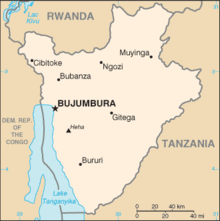November 1966 Burundian coup d'état
On 26 November 1966, Michel Micombero, Burundi's 26-year-old Prime Minister, ousted the 19-year-old king (mwami) of Burundi, Ntare V, in a coup d'état. Ntare was out of the country at the time and the coup leaders quickly succeeded in taking control. Micombero declared an end to the monarchy and the Kingdom of Burundi became a republic with Micombero as its first President.[1]
 | |
| Date | 26 November 1966 |
|---|---|
| Location | Bujumbura, Kingdom of Burundi |
| Type | Military coup |
| Motive | Regime change |
| Target | Royal Palace, Bujumbura |
| Organised by | Michel Micombero |
| Outcome | Coup succeeds
|
| History of Burundi |
|---|
|
|
Burundi 1962–present
|
|
Current
|
Background
The November coup of 1966 was the last of three coups to take place in Burundi during 1965 and 1966. The previous coups (in November 1965 and July 1966) followed the assassination of the country's Prime Minister, Pierre Ngendandumwe on 15 January 1965, and the country's first parliamentary election in May 1965. The assassinations, attempted coups, contentious elections and ethnic cleansing campaigns combined to make the period immediately following independence a tumultuous one for Burundian society.
Aftermath
The November 1966 coup was the third Burundian coup in 13 months and Micombero, a Tutsi, ruled the country for the next 10 years, including during the Ikiza, the first of the Burundian genocides, in 1972. Micombero was eventually ousted during a bloodless coup in 1976.[2]
References
- "MICHEL MICOMBERO, 43, DIES; FORMER PRESIDENT OF BURUNDI". The New York Times. 1983-07-18. Retrieved 24 April 2020.
- "Michel Micombero". TheFreeDictionary.com.
